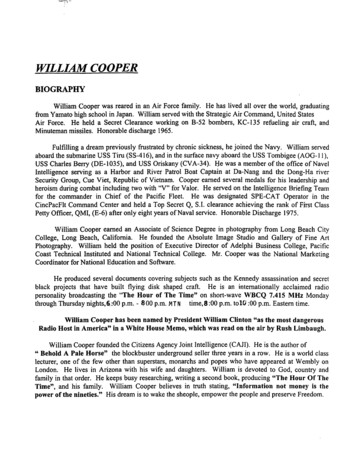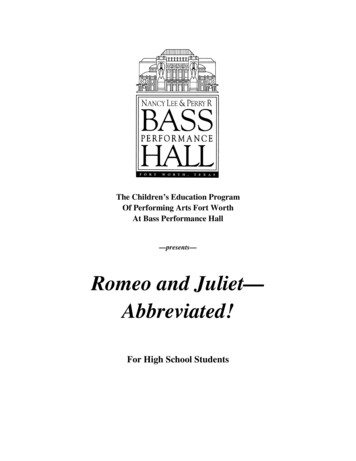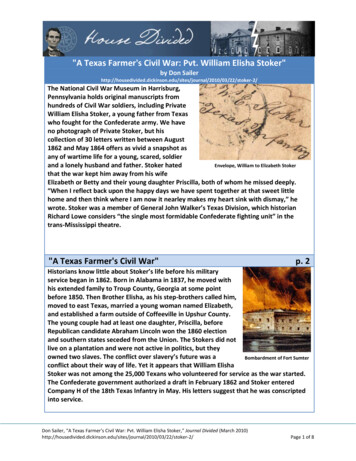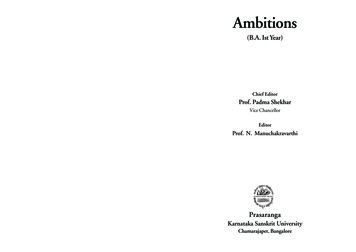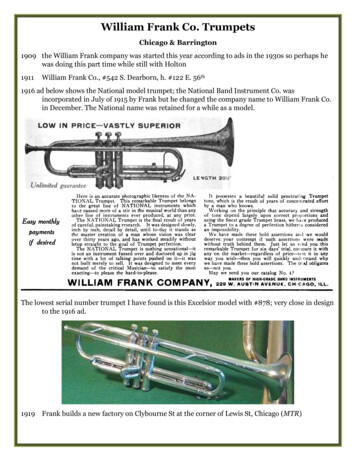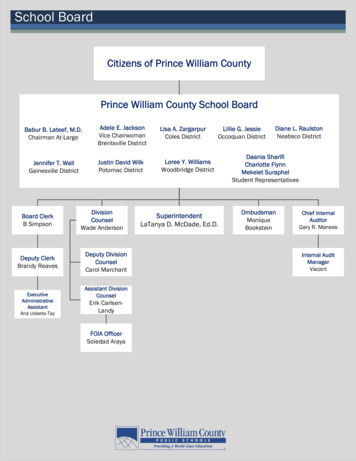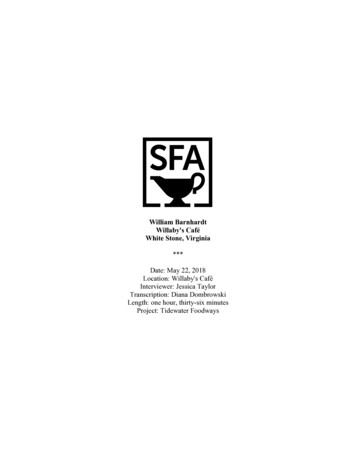
Transcription
William BarnhardtWillaby's CaféWhite Stone, Virginia***Date: May 22, 2018Location: Willaby's CaféInterviewer: Jessica TaylorTranscription: Diana DombrowskiLength: one hour, thirty-six minutesProject: Tidewater Foodways
William Barnhardt—Willaby’s Café 1[START INTERVIEW]JT: This is Jessica Taylor at Willaby’s on May 22, 2018. Sir, can you please state yourfull name?[00:00:10]WB: William Barnhardt.[00:00:13]JT: Okay. And when and where were you born?[00:00:14]WB: I was born in Richmond on July 17, 1964.[00:00:23]JT: Okay. And what were your parents' occupations?[00:00:24.18]WB: My parents were duck farmers.[00:00:28]JT: Okay. Can you talk about growing up at, I guess, the duck farm?[00:00:37] Southern Foodways Alliance www.southernfoodways.org
William Barnhardt—Willaby’s Café 2WB: Well, it was interesting. I think the one thing that strikes me the most is that we hadto have a job during the summer. But whenever it snowed, before we could go sleighriding, we had to pick up the eggs because, if it snowed and the employees couldn't comein, you still had to pick the eggs up. You couldn't go without doing that. Certain functionshad to take place. So, snow days weren't always fun days. [Laughter][00:01:08]JT: Yeah. How did your parents get into duck farming?[00:01:09]WB: It was my grandfather, actually, and he tried different—he moved from Charlotte toUrbanna—Charlotte, North Carolina to Urbanna, Virginia—and he tried different typesof farming. He tried cotton. He tried pigs. He tried chicken, and then he struck ontoducks, and it worked.[00:01:30]JT: Were the previous attempts just not profitable or just not for him, or . . . ?[00:01:35]WB: I don't know which, yeah. But it didn't work out for him. But ducks did, and it was afamily business for sixty years.[00:01:46] Southern Foodways Alliance www.southernfoodways.org
William Barnhardt—Willaby’s Café 3JT: And how big of a business was it? Like how many people worked for you?[00:01:51]WB: At its peak, we had a hundred and sixty-five employees. We would process seventhousand ducks a day, and that would be in the packages, like you'd see a whole chickenin the store. And then we would do 1.5 million ducks a year. Sometimes we would pickup as many as twenty thousand eggs in a day.[00:02:12]JT: Wow. Where were you supplying to with the ducks?[00:02:17]WB: Well, the ducks sold—like, three quarters of our inventory would sell during thefall, Thanksgiving and Christmas. Mostly in the Northeast, but all throughout the UnitedStates. At one point, we packed under twenty-five different labels, like A&P andSafeway, as well as some other duck farms would have us package under their labels.Yeah, especially farms in Long Island, where they get more per pound for their duck, soit was worthwhile for them to have us pack under their label.[00:02:53]JT: Wow. What was the relationship like between your parents' duck farm and—was it inUrbanna, or—the Urbanna community? Southern Foodways Alliance www.southernfoodways.org
William Barnhardt—Willaby’s Café 4[00:03:03]WB: It was just outside of Urbanna. It was actually behind Rosegill Farms, so it wasabout a mile and a half to get to Urbanna. The relationship? Well, with a hundred andsixty-five people in the rural community, there were a lot of people that were employedthere. Some of the local restaurants carried our duck, and they were in the local grocerystores.[00:03:32]JT: Okay. With economic fluctuations, did that affect your parents at all?[00:03:35]WB: Yeah. Well, the move of agriculture is to a smaller number of larger players, andgiven our location, the dynamics just weren't in place for us to be bigger. The farms thatwork now are closer to the Grain Belt, so it's easier to get the grain that they need to feedthe ducks, and they're also a little further north, because the heat can really take a toll onducks. Ducks prefer cooler weather. So, the bigger farms are in Canada and Wisconsinand Indiana.[00:04:20]JT: Okay.[00:04:22]WB: Yeah. Southern Foodways Alliance www.southernfoodways.org
William Barnhardt—Willaby’s Café 5[00:04:24]JT: And you said you were supplying primarily to the Northeast. Is there a reason for thatbeyond there's more supermarkets up there?[00:04:29]WB: Cultural. That there's a lot of demand for duck in Chinese markets, and you've gotChinatowns in New York City and Baltimore. That drove it. It's more cultural, that therewas more consumption of duck in the Northeast, based on the cultural mix of theNortheast more than there would be in the Southeast.[00:05:01]JT: Yeah, yeah. So, what did your parents cook at home?[00:05:07]WB: I remember my mom's chili, and I remember her oyster stew. I remember my fathergrilling fish outside on the grill. We had duck once a month. [Laughter][00:05:27]JT: That's fair, yeah. [Laughter][00:05:27]WB: And it worked out. I never got tired of it. Duck's delicious. Southern Foodways Alliance www.southernfoodways.org
William Barnhardt—Willaby’s Café 6[00:05:31]JT: Okay. What made your mom's chili so special?[00:05:34]WB: That's a good question. I think the mix of beans, the variety of seasoning, the chunksof tomatoes, are what I remember. We kept that recipe and we serve it in here now. Yeah.So, that and we do my mom's oyster stew, same recipe, and serve it in here now. They'reboth popular items. So, that worked out.[00:06:04]JT: Can you describe those recipes a little more?[00:06:05]WB: Our chili has got twenty-two different ingredients, so it takes a while to put togetherand it takes a while to compose. You really need to keep it simmering on the stove for aday before you serve it. The oyster stew has got a really unique flavor. We like to add theoysters, cook them and add them to order, so that they don't get smaller while you keepthe soup kettle hot.[00:06:35]JT: Oh, okay. Okay. Southern Foodways Alliance www.southernfoodways.org
William Barnhardt—Willaby’s Café 7[00:06:35]WB: Yeah, it keeps oysters plump.[00:06:38]JT: What kind of broth was in the—was it a broth stew, the oyster stew?[00:06:40]WB: Mm-hm, yeah. It's cream-based, yeah.[00:06:47]JT: Okay. I don't want to divulge any of your secrets. [Laughter] Or anything. Howevermuch you tell me—[00:06:52]WB: I think one of the things that makes it—I think it's probably hard to pick out thatgives that soup a real punch is . . . using hot chili powder, using cayenne chili, usingcayenne pepper in the finish of it. Just a tiny little pinch, and it helps. It just brings abrightness to the cream that I think makes it kind of unique.[00:07:32]JT: So, at home for holidays, did your parents do anything special food-wise? Desserts orbigger dishes, bigger family gatherings? Southern Foodways Alliance www.southernfoodways.org
William Barnhardt—Willaby’s Café 8[00:07:44]WB: The thing that I remember the most was pickled watermelon rind.[00:07:50]JT: Really?[00:07:51]WB: Oh, yeah. I can taste that right now. Yeah, it's delicious. And it's firm, it's a littlecrunchy. Oh yeah, yeah. That was the thing that I think I looked forward to the most.Spoonbread not so much, not when I was a kid.[00:08:04]JT: Really?[00:08:04]WB: Yeah, 'cause it's a Southern style, it's not real sweet. Yeah. I think that, and the friedoysters. Yeah.[00:08:17]JT: How did your mom make pickled watermelon rind? Do you remember what herprocess was?[00:08:23] Southern Foodways Alliance www.southernfoodways.org
William Barnhardt—Willaby’s Café 9WB: I don't remember her process, no, but they're certainly a sweet pickle. And it's . . .yeah, that's all that I really know. I've never made those pickles. I should look into it.‘Cause, now that you mention it, I'm thinkin' how good they taste. [Laughter][00:08:42]JT: Do you remember, for oysters, what she put into the batter she fried them in?[00:08:47]WB: Just salt, pepper, flour, some cornmeal.[00:08:54]JT: Okay. Where did she get the oysters from?[00:08:57]WB: Well, then they would have probably come from Ferguson Oyster Company,because my dad and Waverly Ferguson were good friends. So, most likely, they wouldhave, at Thanksgiving, traded a duck for a gallon of oysters. Something like that wouldhave happened.[00:09:16]JT: Uh-huh. Okay.[00:09:17] Southern Foodways Alliance www.southernfoodways.org
William Barnhardt—Willaby’s Café 10WB: Yeah. At that time, there were a lot of oyster houses up and down theRappahannock River. Not as many now, but . . .[00:09:28]JT: Do you remember the fluctuations in seafood at that time?[00:09:28]WB: No.[00:09:30]JT: When you were growing up?[00:09:30]WB: Uh-uh. I don't remember it, but I wasn't aware of the market. I don't think I was asaware of the market. We always had oysters, yeah. Local people always have oysters.[00:09:44]JT: Before we move on from the duck farming and your parents, I wanted to see how thetechnology of processing duck changed over time, especially as you got bigger.[00:09:54]WB: Well, it's interesting, because I've recently seen some video footage that was takenof the area, and I saw the ducks being loaded into a wooden barrel with ice, and I was Southern Foodways Alliance www.southernfoodways.org
William Barnhardt—Willaby’s Café 11aware that that happened when we were young. It would get loaded on to the steam boatsand carried up to Baltimore. That's where I think most of the things went that weregathered. That was kind of a central hub for distribution. And I remember as a kid, theold, abandoned processing plant down at the water, and that probably was positioneddown at the water because it was closer to load the ducks onto the boat. You know, Iremember the shackles there. I remember shackles—I remember the processing linehaving a lot of steel and it bein' real rusty and, certainly, the one that I grew up with wasall stainless. Certainly, that would have changed over time. And we had freezers. Wedidn't pack ducks in ice. We would freeze them because three-quarters of the inventorywould go out all at one time. You would build up that inventory in a freezer the size of agymnasium. Because 1.5 million ducks is a lot, and you store three-quarters of that for itto zoom out at Thanksgiving and Christmas.[00:11:31]JT: Yeah. So, what ultimately made your parents decide to leave that behind? Or is it stillin the family?[00:11:39]WB: It's not in the family, no. It just . . . it got into debt, you know? It's like I said, inagriculture, you either grow or you go away. Or you diversify into a specialty cut orspecialty processing of some type. But yeah, especially in agriculture, you've got to bemoving somewhere, doing something that changes. We didn't do that. We didn't have theopportunity to grow bigger. We tried some different methods, but it's more difficult for us Southern Foodways Alliance www.southernfoodways.org
William Barnhardt—Willaby’s Café 12to expand down here as property values went up. They had the same problem on LongIsland. There's not nearly as many farms, if there are any left. I'm not even sure that thereare any left anymore because the property values go up. You can't expand your farmbecause it costs so much to capture that land to be able to grow ducks on.[00:12:47]JT: Yeah. So, how did you become interested in food as a career option?[00:12:52]WB: When I was young, my father would go around places and cook duck, like atgrocery stores, to get people interested in it. Like you go into a grocery store today andyou see people giving out samples of something to get people interested. That was whathe would do. He would set up a little electric rotisserie and rotiss duck, and give peoplesamples for them to try. And then that grew into us doing some at a festival. We set up abooth and we were sampling duck at it, at the Urbanna Oyster Festival. When I went tocollege and told people that I grew up on a—that my family business was a duck farm, itsort of maybe gave them weird images of what that meant. So, I kind of did the samething. I'm like, okay, let me bring this to reality for 'em. I cooked some duck one night,and then that turned into a party that we did at a house off-campus. By the time Igraduated, we were serving twelve hundred people at a college of two thousand. Yeah.[00:14:03]JT: Where did you go to school again? Southern Foodways Alliance www.southernfoodways.org
William Barnhardt—Willaby’s Café 13[00:14:03]WB: Lynchburg College.[00:14:05]JT: Lynchburg College, okay.[00:14:05]WB: Yeah. Right here in Virginia.[00:14:07]JT: What were some of the images or misperceptions that people had about duckfarming?[00:14:12]WB: That it might be raising ducks to have at ponds and parks. [Laughter][00:14:20]JT: Okay. [Laughter][00:14:22]WB: When you think about duck, some people don't think about eatin' duck. They thinkabout Donald Duck, all the cute things that duck brings up. So, yeah, that's what it was. Southern Foodways Alliance www.southernfoodways.org
William Barnhardt—Willaby’s Café 14[00:14:35]JT: Okay. So that got you interested in pursuing food as a career option?[00:14:40]WB: Yeah, it actually became a senior thesis, because I was a business major. And doing,growing that party, that food festival, that kind of private food festival, got me interestedin doing catering and carrying that concept, that private food festival, to other colleges.We successfully brought it to Radford, to J.M.U., and to Mary Washington College. Andfrom there, went into catering weddings. Because the catering is cyclical, especially inthe spring and the fall, those are your busiest times, when the weather's really nice to beoutside and to have weddings and family gatherings. I realized I needed to have arestaurant, a base to work out of, and something to keep employment, keep a consistentbase of operation. So, after five years of doing just catering, I opened up the restaurantand that was . . . twenty-five years ago. Twenty-six years ago.[00:15:59]JT: Okay. So, what kind of experience did you want to bring customers with your initial . . doing the restaurant?[00:16:04]WB: Local. What I grew up with, you know? Especially the crab cakes and the oystersand the oyster stew. The same thing that I was doing at colleges, 'cause what I was doing Southern Foodways Alliance www.southernfoodways.org
William Barnhardt—Willaby’s Café 15with the duck fest was, I brought duck. We brought oysters. We brought steamed crabs.And clams. Things that I grew up with, things that are from this area that I was familiarwith. I would come home, pick up these foods, bring 'em back to school, and cook 'em upat a big party. That was the same thing that the restaurant became, was representing. Itwas easy to think about. That's the foods right at your hands, so why not use 'em?[00:16:51]JT: Yeah. Where did you learn to cook seafood?[00:16:55]WB: Probably just from my mom.[00:16:57]JT: From your mom?[00:16:57]WB: Yeah. Because I liked to throw the parties at college, learning, and so I learned howto grill on a large scale. Yeah. But that's . . . yeah. I would say my passion for cookin'food definitely came from my mom, for sure.[00:17:14]JT: Why is that? Southern Foodways Alliance www.southernfoodways.org
William Barnhardt—Willaby’s Café 16[00:17:14]WB: Gosh, I mean every time we sat down at the table, there'd be something different onthe table. It didn't work out too well for me when I was a kid, but I got to appreciate it asI got older. [Laughter] I would have been happier with a hot dog every night. [Laughter][00:17:32]JT: With the seafood, did she have any signature way of doing things in the kitchen, evenusing appliances or . . . ?[00:17:41]WB: I think this signature that I remember is using cast iron to sear, yeah. As I've gottenolder, that's a beautiful thing, you know? The only pans I have at home are cast iron, andwe cook all of our crab cakes here on cast iron. We use cast iron skillets. We don't do 'emon the flat top or drop 'em in the fryer like most places do. We use a little skim of oliveoil and sauté 'em in cast iron. It gives a sear that you can't get in any other kind of pan.When you go to the store or watch commercials on TV, you constantly see these newpans, the green pan, the copper pan, all that stuff. It's . . . there's nothin' like cast iron.And the old cast iron, the cast iron that's made before the 1930s, is just . . . there's nothin'like it that's new.[00:18:40]JT: Is that what your mom used at home, old cast iron? Southern Foodways Alliance www.southernfoodways.org
William Barnhardt—Willaby’s Café 17[00:18:41]WB: Um-hm. Yeah. That was passed up from her grandmother. I mean, I'll pass mine onto my kids, too. Yeah, that stuff doesn't get old. Unless you somehow apply so much heatthat you can actually warp it, yeah. If you keep 'em seasoned, I can't imagine mine evergoing away. Yeah, yeah. You don't lose the surface on cast iron 'cause you create it.You're seasoning and creating a surface on the cast iron to cook on. That's the seasoningof it, right?[00:19:20]JT: Wow, that's beautiful.[00:19:23]WB: [Laughter] It is beautiful.[00:19:23]JT: Yeah. It's really, it's wonderful, yeah. So, the time has come for me to ask you aboutcrab cakes.[00:19:23]WB: Um-hm.[00:19:31]JT: So, with as much detail as you can, how is the optimal way that you make crab cakes Southern Foodways Alliance www.southernfoodways.org
William Barnhardt—Willaby’s Café 18here?[00:19:40]WB: Put no vegetable, onions, peppers, in the crab cake, because the flavor, the meat, isso delicate that you just want to season it just to complement the flavor of the crab but notoverwhelm it. That's real important in all cooking, but I think especially with crab cakes,because the flavor of the blue crab, the Chesapeake Bay blue crab, is so delicate andbeautiful. We use an old Tangier recipe, and it's got simple ingredients, just enough ofthings to bind the meat together to sauté in the pan so it doesn't fall apart when you go toturn it over. Then, like I said, we sauté it in olive oil in a hot pan, and . . . I mean, it'spretty simple. It's pretty simple, but in that simplicity is just incredible beauty.[00:20:45]JT: Mm-hm. How did you come across this recipe?[00:20:49]WB: In a Tangier cookbook. Yeah, yeah. And I searched with my mom. She identifiedthat as the recipe that she used, too, and I think it was from Mrs. Crockett's Crab CakeHouse was the official recipe that she used. You know, you can't improve on perfect.[Laughter][00:21:17]JT: Yeah. You said it was a clam chowder, or was it . . . Southern Foodways Alliance www.southernfoodways.org
William Barnhardt—Willaby’s Café 19[00:21:20]WB: The oyster stew is the other, yeah, and that's my mom's, yeah.[00:21:25]JT: Can you walk us through that? You don't have to go into specific ingredients if youdon't want to.[00:21:28]WB: Yeah, yeah. We use heavy cream and, like I said, a pinch of cayenne. We use a littlebit of sherry to give it some body. Just fresh, local, wild-caught oysters. There'ssimplicity in that, too, in that recipe, also. In the restaurant setting, we find it's importantto cook the oysters to order so that they're plump and they're fresh. Each bowl or cup ofsoup, yeah . . . that's as simple as it gets, yeah. Yeah. We've been servin' that since westarted. At first, my mom would bring all the soups to the restaurant, and she took care ofall of the soups. Then we, as we progressed, we were able to take it on ourselves and notrely on her. But we keep a lot of—we keep some of the things that she brought to thetable still alive, yeah.[00:22:43]JT: Yeah, absolutely. So, when you first started, where were you getting your seafoodfrom? Locally or . . . ? Southern Foodways Alliance www.southernfoodways.org
William Barnhardt—Willaby’s Café 20[00:22:52]WB: Um-hm. We were getting our crabmeat from Charles Chase. I can't remember thename of his crab house right now, but we'd drive out there to . . . to where his crab housewas and pick up the crabmeat. We always were getting it locally, getting local, freshmeat. But in the wintertime, we'd get pasteurized meat. There's no difference, absolutelyno difference. Especially once you cook with it. I mean, I don't think right out of the canthat you can really notice the difference between pasteurized and fresh. We gotpasteurized in the winter because I’ve never thought that dredging crabs is the right thingto do. You know, it kills as many crabs as it harvests, because crabs burrow at differentlevels. So wherever the rake is set, it's either gonna tear the back off a crab or it's gonnaharvest the guy that was shallow. The deeper guys, they're gonna get speared. I don'tthink it's—and it disrupts the natural layers of the bottom of the river. So, I've never feltlike dredging is the right thing to do. We don't support that, just like we don't supportveal. We've never served veal. I don't think that that's the right practice, right thing to do.[00:24:27]JT: Does that come from your time as a kid on a duck farm?[00:24:31]WB: Well, I suppose so. Yeah. I mean, it's enough to harvest animals, but you've got totreat them properly, yeah. We use only fresh eggs here that are from a local farm. They'reway different from what you get in the grocery store. It's because of the way they'retreated, you know? They're able to run around in the field and chase bugs instead of being Southern Foodways Alliance www.southernfoodways.org
William Barnhardt—Willaby’s Café 21cooped up in massive production facilities. The way you treat the animal affects the yield.[00:25:13]JT: Yeah. With the eggs that you get, where do you get 'em from?[00:25:16]WB: We get 'em from, the farm that we use right now is called the Yellow House Farm.It's a local chicken farm. It's just . . . they have maybe two hundred birds, and they'reright here in White Stone, right in town. They just bring it on down here and, yeah . . .and we buy about sixty dozen a week. We sell a lot of eggs here.[00:25:52]JT: Yeah. How is the flavor different than what you would get at Costco or Food Lion?[00:25:58]WB: It's so much richer. It's so much more complete. I mean, the flavor that you get fromeating an egg, it's like . . . doubling or tripling that flavor, the intensity. The yolk is muchmore of a—it's a darker color. It's got more color. The texture's smoother. It's reallyinteresting. We make hollandaise from the egg yolks, and we haven't always had fresheggs available to us, especially in the volume that we use. We used to use regular eggs.Since we switched over to the farm eggs, the hollandaise is so bright and beautiful on topof the poached eggs now that we serve on Sundays. It is gorgeous, it is beautiful. Southern Foodways Alliance www.southernfoodways.org
William Barnhardt—Willaby’s Café 22[00:26:59]JT: What changed that made it so that the fresh eggs were available to you? Was it thatthe farm started, or . . . ?[00:27:06]WB: That the interest in that has grown, and that the interest in that farm-to-table and thatthe supply was able to be enough for it. We tried lettuces long ago, but the time period—we tried a lot of different local produce since we've started. But the availability is just sodifficult and varies so much. One day you might get zero, and the next day, you might getenough to work on for a couple of days. But then, in a restaurant, you've got to keep theproducts on your menu. You've got to keep them consistent. People come in, they wantthat flavor they had last time. They want that salad, they want that whatever it is that theyhad last time or that they're lookin' forward to having. You know, you gotta make itavailable. The way that we run our business, we keep the same menu year-round. Sopeople are familiar, they're comin' back for the flavors that they had. So, you've got tomake decisions on how you make that happen. Some restaurants vary their menu almostdaily depending on what's available. That's never been our model, as a larger restaurant ina rural area. That's harder to do. Smaller restaurants it's easier—it's more doable. Iwouldn't say it's easy.[00:28:39]JT: How has availability and anticipating availability changed since the [19]80s? Southern Foodways Alliance www.southernfoodways.org
William Barnhardt—Willaby’s Café 23[00:28:45]WB: . . . Gosh. Zero to sixty?[00:28:52]JT: Okay. [Laughter][00:28:55]WB: I mean, I don't know how else to say it, you know? When it was so difficult to find,and now it's much more readily available. Now there are farm stands that are set up yearround that provide local produce, and that's . . . we didn't have anything like that before.Now, there are regular, local—what do they call it, on the weekends? We have farmmarkets in certain places every week. Every Saturday, in this area, you'll find farmmarkets. We never had that before. You know? Just wasn't any interest. But I think thatthere's some frustration with the commercialization of food, that people—it keepsratcheting up, and I think that people have gotten to the point where they're reacting tothat. They don't want just whatever's handed to them in whatever way that it can get tothem in the cheapest method. They want things, they realize that there's . . . I think,through that process, flavors have gotten washed out, too. I think when people make aswitch to a farm-fresh egg, they realize, "Wow. I don't want that washed-out flavoranymore. I don't want that injected . . . hormone-fed, caged-up process anymore." Whenyou get those flavors, you realize the connection, and how the process needs to go back tomore traditional ways than what it's turned into. Southern Foodways Alliance www.southernfoodways.org
William Barnhardt—Willaby’s Café 24[00:30:49]JT: Yeah, absolutely. So, what has the relationship been like with your distributors—notdistributors. The guys that do the fishing and the local egg folks and farm market folks?[00:31:06]WB: You know, it's cool. We do a lot of our shopping at local supermarkets. They do theground beef. We always have gotten our ground beef locally. It's superior to anything wecan get. There's a local grocery store, Tri-Star, has a small meat department that still cutstheir own meat. They don't just get 'em in the packages and put the prices on them. Theywould cut it and they grind it and they take a lot of pride in their work. It's beautiful.They cut all our steaks, and the cool thing is, because they know that we like qualityproducts, when they're cutting steaks throughout the day and they run into a beautifulpiece, they'll cut those steaks for us and send 'em to us. How's the relationship? Therelationship is those guys come down here and get hamburgers and steaks. [Laughter]'Cause they know what they're gettin', right? They're takin' pride in it. So, they almostfollow our vehicle back down here to get the food. It makes a nice little circle, you know?Same way with the oysters. It's a place real close to my home, so I can pick up the oysterson the way in, and it's the same way. Those guys come here and get seafood, 'cause theyknow where it comes from. And it's small family businesses. You build relationships, youknow? You build relationships with everybody in the meat department, check out people,all the—there are a lot of Mexicans that work at the oyster house. They found that thatlabor force works out well for them. Build relationships with them, learn Spanish, youknow? And . . . you realize that there's this whole other aspect that comes with it, and it's Southern Foodways Alliance www.southernfoodways.org
William Barnhardt—Willaby’s Café 25about relationships. It's about deepening relationships, and through that process, youcreate better for the community, I think, because we're gettin' the best oysters from theoyster house, the Kellum’s, we're gettin' the best meat from the grocery store. It just . . .it's satisfying, just the process of going and gathering these things, because of therelationships and the energy that you share when you go to these places. It's all sosatisfying. You know you're getting top-shelf; you're delivering the best that you can getfrom the area.[00:34:04]JT: Do you have a particular person that you look forward to working with over thecourse of the week?[00:34:11]WB: Oh, yeah. Oh, yeah.[00:34:14]JT: Okay.[00:34:14]WB: Well, Michael Painter that runs the meat department . . . he operates on many levels.And also, he's a musician, so he performs here and he helps with contracting themusicians for our Thursday nights. So, there's multiple levels we can contact on, plus thatmakes it a lot more interesting. There's a guy—and I don't know where in Mexico he's Southern Foodways Alliance www.southernfoodways.org
William Barnhardt—Willaby’s Café 26from. He's told me, but . . . his name is Cheque, and he teaches me Spanish every time Igo down to the oyster house. I, in respect him and his culture, try to learn that and speakwith him in Spanish when I'm down there, because I know that that's more respectful.When you go to a foreign country you, as much as possible, try to speak in that tonguebecause that's respectful. Respect works. [Laughter][00:35:28]JT: Yeah. You know, I've talked to very few people that have been inside the oysterhouses. What is that like in there for you as a person that owns a restaurant?[00:35:38]WB: Oh. Well, Kellum’s runs such a clean operation. So, when I go in there, everythingis just at really high cleanliness standard. Otherwise . . . I mean, I watch them packoysters. Sometimes I'll come in there and they'll pack the oysters right in front of me, so Iknow the quality, I know the sanitation. And the shell oysters, too. Sometimes we get theshell oysters from them, as well, that we'll shuck out, for oysters in the half shell. I cansee the piles of beautiful oysters and, yeah, that . . . that's a fantastic connection, whenyou see . . . when you've been raised on the river and you packed oysters, you wereweaned o
WB: It was just outside of Urbanna. It was actually behind Rosegill Farms, so it was about a mile and a half to get to Urbanna. The relationship? Well, with a hundred and sixty-five people in the rural community, there were a lot of people that were employed there. Some of the local restaurants carried our duck, and they were in the local grocery




